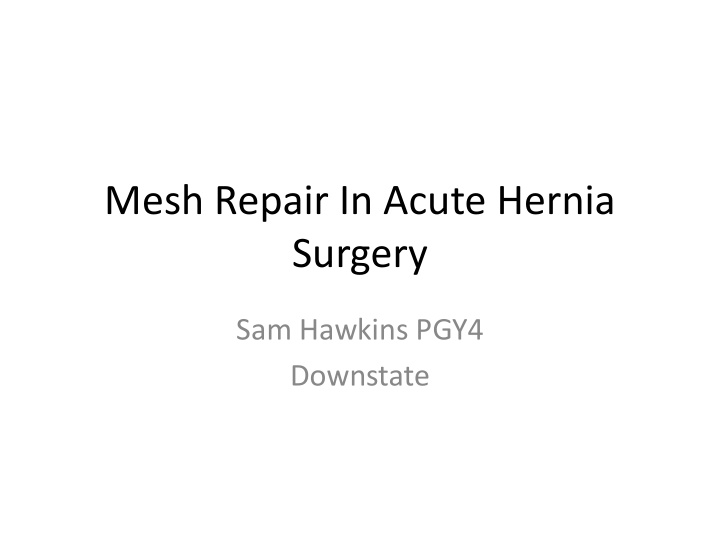



Mesh Repair In Acute Hernia Surgery Sam Hawkins PGY4 Downstate
Case Presentation • 72F • HTN, DM, CAD s/p CABG, GERD • Active MI, evolving AKI, respiratory de- compensation • Known umbilical hernia, report of acute enlargement in past 24h
Case Presentation • 98.7; 110/89; 86 • Intubated, sedated but arousable • Abd obese, obvious umbilical bulge w/ ttp, tense, skin w/ erythema
Case Presentation • Labs: – CBC: 29.68/7.7/24.7/547 – BMP: 135/3.7/100/23/44/3.51/239 – Trop: 2.6->5.1->12.8
Case Presentation • To OR – Exploration of hernia: omentum, large omental hematoma, small bowel, large bowel – Reduction of hernia contents without bowel resection – Excision of hernia sac – Swiss cheese fascia – extension of fascial incision to include other defects – Placement of underlay mesh with trans-facial sutures – Closure of fascia over mesh – Skin closure with staples
Case Presentation • Post-op course – POD 2 extubated – POD 2-7 BID dressing changes for moderate to significant serous drainage from staple line – POD 7 staple-line vac dressing placed, removed POD 14 – POD 22 staples removed – Pt currently in residence on telemetry, no recurrence or complications
?
Mesh Repair in Acute Hernia Surgery • Mesh is great! • Mesh = a non-native matrix of biologic or synthetic material used to augment the surgical repair of native tissue defects
Q1: What is the principal psysiologic advantage to use of mesh in hernia repairs? A. Increased inflammatory reaction leading to more dense adhesions within and around the fascial defect B. Decreased tension on fascial suture lines C. Increased post-operative pain deters patients from early activity and disruption of the repair D. A and B
Q1: What is the principal psysiologic advantage to use of mesh in hernia repairs? A. Increased inflammatory reaction leading to more dense adhesions within and around the fascial defect B. Decreased tension on fascial suture lines C. Increased post-operative pain deters patients from early activity and disruption of the repair D. A and B
• Polemic • Strongly in favor of use of mesh in contaminated fields • Represents a position paper on a subject that is controversial
Proposition: Use of mesh in contaminated fields creates an unacceptable risk of wound infection that could necessitate mesh removal
Proposition: Use of mesh in contaminated fields creates an unacceptable risk of wound infection that could necessitate mesh removal Real Question: I’m repairing a hernia that is acutely incarcerated or strangulated, should I use mesh or close primarily?
• NSQIP • 33832 ventral hernia repairs with mesh determined by CPT 49568 • 30106 ventral hernia repairs without mesh determined by CPT codes 49560 or 49561 • Demographics and perioperative factors compared • 30 day follow-up
Q2: Which of the following statements is FALSE? A. NSQIP stands for National Surgical Quality Improvement Program B. NSQIP started within the VA system before becoming an ACS spearheaded program involving non-VA hospitals C. All of the top 12 hospitals in the US News and World Report Best Hospitals ranking participate in NSQIP D. NSQIP participation is exclusive to US hospitals E. A participating hospital must hire a Surgical Clinical Reviewer (SCR) to collect preoperative through 30-day postoperative data on randomly assigned patients
Q2: Which of the following statements is FALSE? A. NSQIP stands for National Surgical Quality Improvement Program B. NSQIP started within the VA system before becoming an ACS spearheaded program involving non-VA hospitals C. All of the top 12 hospitals in the US News and World Report Best Hospitals ranking participate in NSQIP D. NSQIP participation is exclusive to US hospitals E. A participating hospital must hire a Surgical Clinical Reviewer (SCR) to collect preoperative through 30-day postoperative data on randomly assigned patients
• Their analysis leaves out: – Emergent vs elective – Mesh type: biologic vs synthetic – Mesh placement: onlay vs inlay vs underlay etc (see Praz) – >30d complication rate – Intervention for infection complication – Comparison of OR for mesh vs non-mesh
Real Question: I’m repairing a hernia that is acutely incarcerated or strangulated, should I use mesh or close primarily?
Outline • Mesh vs No Mesh in Contaminated Cases – The Parastomal Hernia • Mesh in Contaminated vs Non-Contaminated Cases • Mesh in Acute Repairs • Mesh in repairs coincident w/ GYN procedures – there is nothing
• Parastomal Hernia – Incisional hernia related to enterostomy – Incidence for colostomy 3%-39% – Incidence for ileostomy 0%-6% – Surgical treatment can involve: • Relocation of the stoma • Repair with mesh • Repair without mesh • Laparoscopic vs open approach – Contaminated
• Meta-analysis • Relocation excluded • Weighted pooled cases: – Suture repair: 106 – Onlay mesh repair: 157 – Retromuscular mesh repair: 42 – Open intra-peritoneal mesh repair: 45 – Laparoscopic repair: 338
Onlay Intra-peritoneal (Underlay) Retromuscular (Sublay)
Keyhole Sugarbaker
• Retrospective review • 177 pts • Mesh vs No Mesh in contaminated fields
• Retrospective review • 163 pts • Clean vs Contaminated using Mesh
• Retrospective review • 100 pts • Clean-contaminated vs Contaminated using Mesh
A Comparison • Xourafas et al – Mesh vs no mesh – USE CAUTION • Abd Ellatif et al – Contaminated vs Clean – USE MESH • Carbonell et al – Contaminated vs Clean- Contaminated – USE MESH
• Prospective review – still descriptive • 80 pts • Their results vs ?
• All cesarean +/- hernia repair • Small study sizes • Repair vs no repair • No mesh
Conclusions • Board answer: Contaminated Field = Primary Repair • Acute Hernia Surgery = OK for mesh (if no contamination) • Need more studies, good studies, BIG studies
Recommend
More recommend